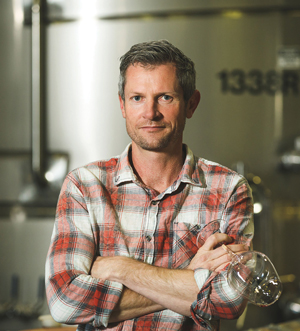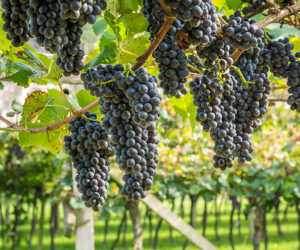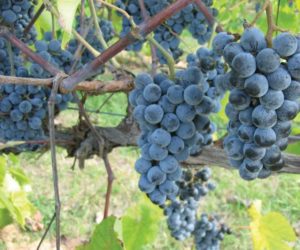Translated into English, Pinot Noir means black pine, based on its grape cluster density evoking a similarity to pine cones. This grape cluster density means that Pinot Noir grapes are especially susceptible to vineyard disease. Its thin skin and lower phenolics can prove to be hard to handle in the winery. It takes a special touch for winemakers to produce a high quality Pinot Noir wine. Learn from two pros adept at handling this grape varietal.
 Senior Winemaker: Kyle Thompson at Saint Clair Family Estate in Marlborough region New Zealand
Senior Winemaker: Kyle Thompson at Saint Clair Family Estate in Marlborough region New Zealand
When it comes to Pinots, I’m looking for overall balance with no one element overpowering the next. I’m looking for concentration and purity of the fruit expression, floral perfume notes like violets and perfumed wild flowers which only really arrive when picked at the peak of ripeness. I like a gentle use of oak, and a fine tannin structure which shows a gentle, respectful handling of the fruit at the winery. I don’t like to see the alcohol dominating as this creates too much power to the wine, firing up the oak component, making it stand out and destroying elegance — it’s a fine line between power and elegance and somewhere in between creates a tension in the wine that’s intriguing. Some of the great Pinot Noirs that I’ve tried in my life, I find myself smelling the glass for a long time, thinking about the wine before I realize I haven’t even tasting it yet.
Pinot Noir is a very open and honest variety and clearly shows the influence of where it was grown: The soil, climate, the season, viticulture, and winemaking approach. What I look for in the vineyard is vine health first and foremost monitoring this through the ripening season. I want a good even fruit set, with small bunches and small berries creating a good juice-to-skin ratio. As the flavors start to develop in the berries, I’m looking for a little bit of yellowing around the fruit zone but not creeping up into the canopy, keeping a nice strong canopy is essential, and also keeping the berries small and concentrated. As the berries move close to harvest I want to see nice brown seeds that don’t have bitter phenolics when I crunch them in my mouth (kind of like roasted sunflower seeds). I pick on flavor, so as harvest date approaches I will taste the berries more frequently waiting until the berries reach a point when the combination of seed maturity, fruit intensity, skin phenolics, and the correct sugar level feel totally balanced in the vineyard. I’m planning my fermentation regime for each block while I’m walking the vineyard.
I always keep my free run and pressings together — I find that if the grapes are ripe and the seeds and phenolics are ripe, then the pressings are essential for overall balance of the resultant wine. I do use commercial yeast for control, but I also use the native wild yeast strains (wild fermentations) in some vineyards that would benefit from it. I like hot fermentations sitting around 30–33 °C (86–91 °F) with regular gentle hand plunging. I like my Pinot Noir to spend a good five days cold soaking before inoculation.
When it comes to oak treatments, it all depends on the season and what each individual vineyard or clone has given me in any particular year. I like to use only French oak and mainly in the realm of 20–40% new oak per batch. Some batches only receive old seasoned French oak – depends on the structure of the young wine. I usually keep the wine in oak for 10–12 months — once again observations in the vineyard play a part in oaking decisions.
 Winemaker: Greg Morthole, Davis Bynum Winery in Healdsburg, California
Winemaker: Greg Morthole, Davis Bynum Winery in Healdsburg, California
We pick our Pinot Noir grapes based on acidity levels more so now than we did in the past. The sugar levels can run away from you, depending on the warmth of the growing season, and that’s ok, but poorly understood by most. We pick as close to our optimal window as possible, which would not be described as under or overripe by any means. My favorite Pinots tend to have a juice pH in the 3.55–3.65 range.
In the winery, we use only free run in our Davis Bynum Pinots, but I think taking only a hard cut press fraction is necessary for each press load. Then the hard cut press fraction can be fined separately, and tasted to determine if it’s ok for inclusion. That would be for our Rodney Strong RRV Pinot. Oak has traditionally been French, but I’m experimenting with Hungarian right now. The amount of new oak has dropped moderately, from 30% to 25%, which I think allows the fruit expression to show better.
When I am tasting Pinot Noir wine, I look for complexity. I like the fruit to be fairly forward, but I like the savory earthy, spicy and floral elements to be there in the most complex wines. We do native yeast fermentations, which has shown more complexity in our trials — not surprising when you consider that dozens of yeast fermented the wine instead of just one. Fermentation temps at 75–80 °F (24–27 °C) favor more forward fruit flavor and richness than fermentation at 65 °F (18 °C), which I tried last year in three trials. Obviously I prefer the warmer temperature fermentations.
An aspect winemakers should identify is Pinot’s vintage-to-vintage variations. Vintages grown in warmer years can be ready to drink early, or can be aged a little longer than average to let the tannins mature. Cool vintages are the real age-worthy ones, if so desired. It just depends on your taste.

 Winemaker: Greg Morthole, Davis Bynum Winery in Healdsburg, California
Winemaker: Greg Morthole, Davis Bynum Winery in Healdsburg, California





